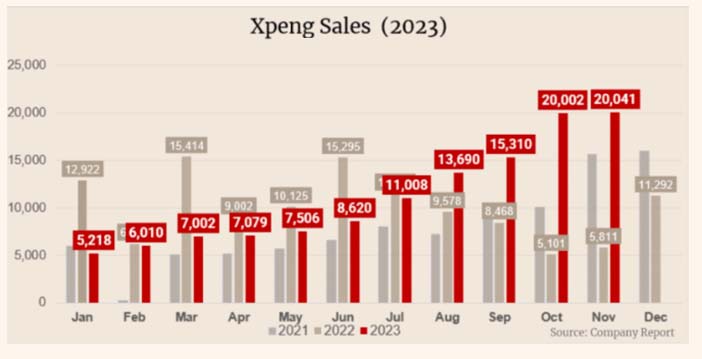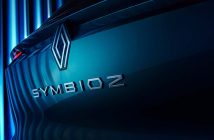+++ In November, the largest European automobile market was in decline. In GERMANY , 245.701 new passenger cars were registered, which is down 5.7% from last year. Among them, 44.942 were all-electric (BEV); down 22.5% annually. Plug-in hybrid vehicles (PHEV) registered 18.124 units; down 59.3% from the same month last year. MG Roewe got the first spot among China-made brands, registering 1.673 vehicles; down 20,8% from October and basically flat from last year. MG delivered 18.655 cars in Germany in 2023 so far. It was followed by Geely’s Smart, which registered 1.339 EVs; up 51,0% from October and down 7,0% from last year. In 2023, Smart delivered so far 15.655 EVs in Germany. Smart sells only 2 vehicles in Germany: the #1 and the #3. Both cars are all-electric, and the #1 is made in Geely’s plant in Xi’an, while the #3 is assembled in Changxing. Smart is a joint venture between Geely and Mercedes-Benz. Mercedes itself is 20% China-owned as about 10% stake owns Geely Group and another 10% state-owned BAIC, who is MB’s biggest shareholder. Third place goes to Great Wall Motor (GWM), which registered 426 EVs; down 2.29% from last month. GWM expanded to Germany mainly with their Ora brand, which sells their Funky Cat hatchback. BYD sold 350 EVs; up 54,9% in November in Germany, and their cumulative deliveries in 2023 (January – November) are 3.438 vehicles. Geely’s owned Polestar registered 281 EVs; up 3,3% from last month and 83,2% down from last year. Polestar delivered 6.023 EVs this year so far. Its vehicles are produced in Geely’s plant in Hangzhou Bay. It was followed by Nio, which registered 50 cars, down 82,70 from 289 in October and down 47,4% from last year. Nio’s cumulative deliveries from January to November are 1.224 vehicles. In Germany, Nio offers 2 options: standard car buyout or subscription. Companies often favor the subscription as a leasing alternative. Nio officially started deliveries in Germany a year ago, in October 2022. Xpeng hasn’t entered Germany yet and plans to do so in 2024; Aiways registered 0 vehicles, down from 2 in October. For comparisons, Tesla sold 4.923 vehicles in November in Germany, down 54,5% from the same month in the previous year. Part of the deliveries were locally made in Giga Berlin, and part was imported from Giga Shanghai. +++
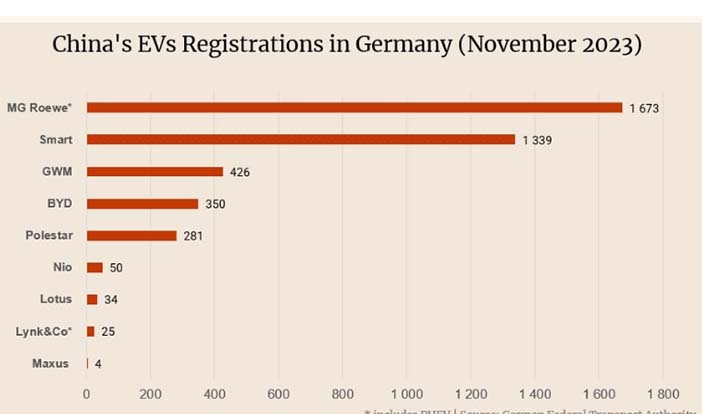
+++ Despite announcing in October that it had dissolved a deal to produce small EVs on a platform shared with General Motors, HONDA fully intends to keep to its commitment to transition to a 100% zero-emissions lineup by 2040. To do so, Honda’s going to need to build some cars. Which ones? Well, it looks like we’re about to find out, as Honda announced Wednesday that it will show its new global electric vehicle series for the first time at CES 2024 in January. “Toward its global goal to achieve carbon neutrality for all products and corporate activities by 2050, Honda will introduce 30 new EVs globally by 2030 with a global sales volume of 2 million units”, the company’s announcement said. “In North America, Honda has laid out an aggressive timeline of EV introductions leading to 2030 and ultimately to 100% zero-emission automobile sales by 2040, which includes battery electric and fuel cell electric powered models”. The announcement was short on details, but Honda did specifically claim that this is a new EV series, rather than a single vehicle, and said it will display those “models” (plural) and several “key technologies” at its booth at CES. Whether those will all be physical concept cars or mostly renderings, the company didn’t specify. Apart from the teaser image, we don’t have much to go on, but I do know it’s a big enough deal that Honda CEO Toshihiro Mibe and EVP Shinji Aoyama will both be on hand to deliver remarks. While GM and Honda’s long-term plans to co-develop smaller cars may be out the window, that doesn’t mean the companies have severed all ties. Honda’s so-new-it’s-not-even-out-yet Prologue EV utilizes GM’s Ultium battery architecture. It’s bigger in size than the CR-V. While the Prologue will likely have a role in the American Honda lineup for several years to come, I wouldn’t be surprised to see an in-house successor in development sooner rather than later. +++
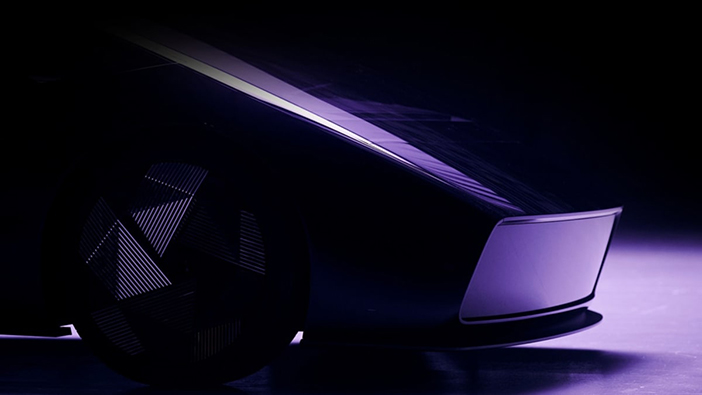
+++ HYUNDAI said Friday its November sales rose 5 percent from a year earlier helped by strong demand for high-end models. Hyundai Motor sold 365.576 vehicles in November; up from 348.280 units a year earlier thanks to strengthened sales of SUVs and its independent Genesis brand’s models, the company said in a statement. Domestic sales surged 18.3 percent on-year to 72.058 units while overseas shipments gained 2.1 percent to 293.518 units. A Hyundai representative said the company will actively respond to the uncertain business environment through optimizing production and sales, as well as improving its product line mix with a focus on high-value-added vehicle models. +++
+++ KIA said Friday its November sales rose 1.7 percent from a year earlier thanks to increased overseas demand for its SUV models. It sold 260.227 vehicles last month; up from 255.836 units a year ago, on increased sales of its Sportage, Seltos and Sorento SUV models, the company said in a statement. Foreign shipments rose 3 percent on-year to 209.637 units last month, but domestic sales slid 3.6 percent to 50.022 units because the EV9 flopped on the homemarket. The Sorento was the most popular model domestically, having sold 9.364 units last month, while the Sportage was the top selling model overseas, having shipped 41.218 units. +++
+++ First, the bad news. If you were expecting the LUCID AIR to get the same interior/technology upgrades as the Lucid Gravity, you will be disappointed. The new hardware, including the wraparound touchscreens, portrait-oriented supporting touchscreen and touchpad steering wheel, won’t be making the jump just yet. Cost and time would be the mitigating factors for that, according to Lucid’s head of design and brand Derek Jenkins. He added that they could be possible in the future for the Air. In the meantime, the good news is that what carries over for the Air is still plenty “wow”-inducing. The changes for 2024 are less about the car itself and more about aligning its various offerings with what customers want. That means fewer choices in some areas and more choices in others. Lucid found that customers were confused by the various powertrain options, especially as they were tied to named trim levels that gained non-powertrain equipment. For 2024, the entry-level Pure is now rear-drive/single-motor only. The Touring is now the entry point for all-wheel-drive/dual-motor. The Grand Touring Performance has been discontinued, but Lucid says that much of what made that version unique is being brought down to the surviving standard Grand Touring trim level. That’ll result in more power and range, but how much is still to be announced. On the flip side, customers are now granted more flexibility in terms of what features can be added to each of those trim levels/powertrains. Pricing for the Pure drops considerably, but base feature content remains the same. Better still, the Pure can now be optioned with items from upper trims, most notably the heated, ventilated and massaging front seats that were one of the top customer demands. You can also now add full leather and natural grain trim, and choose from different interior color schemes. Fathom Blue is added as a color choice throughout the lineup, minus the carry-over Sapphire. The Touring sees its price reduced too, but that is partly due to a reduction in its standard feature content. Much of that decontenting involves features many customers didn’t see themselves using and therefore didn’t like paying for. Lucid mentioned heated rear seats and steering wheel for customers in warmer climates. As such, a new Comfort & Convenience package debuts, which adds those features back to the Touring and makes them available for the first time in the Pure. The package includes heated steering wheel and rear seats, soft-close doors, four-zone climate control and power rear sunshades in both trims, while the Touring further gets power-operated trunk and frunk lids, and heated wipers. Those fancy seats are also optional on the Touring along with leather, granting some customers’ wish for a cow-free interior. The Grand Touring will get that same seating material choice. There were 2 other hot-topic options (or non-options) among customers. The glass roof that had been standard on the Grand Touring is now an option; turns out some people wanted max power and luxury without the sun permanently baking their heads. The glass roof continues to be an option for the Touring. To the surprise of no one in 2023 when black trim rules supreme, the Stealth Appearance package proved to be quite popular and now finds itself as an option on the Touring as well as the Grand Touring. This collection of 32 individual trim pieces is actually much cheaper now. It’s also worth pointing out how Lucid found out what it customers wanted. Because the company directly sells its cars, there aren’t independent dealerships in the way to filter customer data (or eliminate the possibility of its collection entirely). It also used its online configurator to see how people were building their cars, which seems like an obvious thing every car company does, but they don’t. Besides looking at the end “built” car, Lucid could actually follow along with the build process to see which features and trim levels users were going back and forth with. Things like glass roof availability for the Grand Touring vs Touring would show up in such data, for instance. The 2024 modelyear Lucid Air is currently for sale. +++
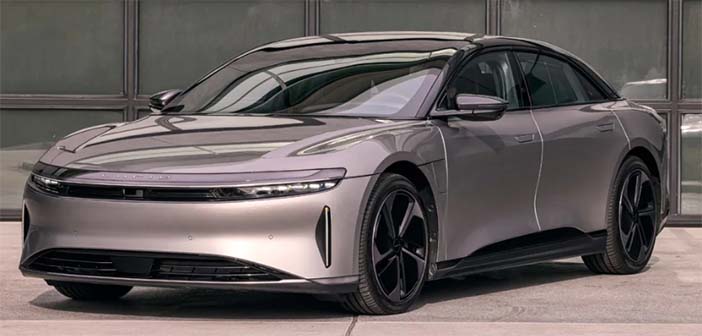
+++ RENAULT KOREA MOTORS , the South Korean unit of Renault, said Friday its November sales plunged 73,9 percent from a year earlier as demand for its models remained weak. Renault Korea sold 4.523 vehicles last month, down from 17.333 units a year earlier due to sluggish demand at home and abroad, according to the company. Domestic sales plummeted 66.2 percent to 1.875 units while exports dropped 77.5 percent on-year to 2.648 units, it said. The company said its best-selling model at home was the QM6 (Koleos) midsized SUV, having sold 1.034 units. Its XM3 (Arkana) was the company’s best-selling model abroad. +++
+++ STELLANTIS is working on hydrogen combustion engines as 1 of 4 different solutions to zero-emissions driving, CEO Carlos Tavares has said. Tavares was speaking at the opening of the Symbio hydrogen fuel cell factory in Lyon, France. Symbio is an equally owned joint venture between Stellantis, automotive supplier Forvia and tyre maker Michelin. Stellantis (which owns 14 car makers, including Alfa Romeo, Citroën, Jeep, Peugeot and Opel) is trying to diversify the number of drivetrains available under European Union decarbonisation rules. “Hydrogen injection is one of the four technologies we’re working on”, Tavares said after the plant opening. He criticised legislators for their “brutal” methods to move car makers away from fossil fuels and steering them towards EVs. “Now the dogmatic thinking is being hurt by reality, because if you aren’t affordable, then people can’t pay for it”, he said. Stellantis is diversifying its drivetrain options to cater to those customers for whom EV charging is a drawback. “The real competition is starting between fuel cell, EVs, hydrogen internal combustion engines and even synthetic fuels”, Tavares said. “We will see in the next few years what is going to be the best solution for the citizens”. Burning hydrogen in combustion engines has been seen as the easiest solution for zero-emissions driving, especially among commercial vehicle makers, given the lack of disruption to supply chains it would cause compared with BEVs or FCEVs. Petrol engines need to be modified to accept hydrogen, but much of the same mechanism remains. The hurdles then are establishing a refuelling network and making green hydrogen at scale. Tavares didn’t say which vehicles would be offered with hydrogen combustion engines, but Stellantis has already begun selling its K0 range of mid-size Vans (think the Opel Vivaro) with a hydrogen fuel cell option. Stellantis will also offer a hydrogen fuel cell version of the Ram Heavy Duty pick-up truck in the US in late 2026 or early 2027, Tavares said. Hydrogen tanks are easier to package in a van, while the lesser weight of a fuel-cell or hydrogen-combustion van compared with a battery-electric one would allow for a greater payload. Toyota has demonstrated hydrogen combustion engines in both Yaris and Corolla race cars running in Japan, while the Renault Group has showcased one in the Alpine Alpenglow supercar concept. Hydrogen and synthetic-fuel combustion engines are favoured by motorsport concerns as they move to zero-carbon fuels, because they retain the sound of current race cars. The idea is also being heavily promoted by European producers and suppliers of heavy-duty vehicle as they look for ways to reduce disruption to their businesses. A consortium called the Hydrogen Engine Alliance, comprised of the likes of Daimler Truck, Claas, Isuzu, JCB, MAN and suppliers such as Bosch, BorgWarner and Dana, has been established to better make the case for the ICE route. Hydrogen combustion engines aren’t considered fully zero-emissions, because of the NOx created by the combustion, but this can be reduced using the same AdBlue treatment as used in diesel engines. They use more fuel than fuel-cell equivalents but are much cheaper to produce. Stellantis’s fuel-cell vans currently cost more than €100.000 without subsidies, commercial vehicles boss Xavier Peugeot told. Tavares said governments need to subsidise the purchase of fuel-cell vans at a rate of €30.000-40.000 per Van for the next “3 to 5 years” to bring the cost down to the level of battery-electric alternatives and stimulate the market. “The price depends on the cost and the cost is something that we need to work on. So far, it’s not there”, he said. Costs are coming down, though. Toyota has said its next-generation fuel cell technology to be commercialised in 2026 will bring “significantly reduced costs”, albeit without saying what the current cost is. +++
+++ A new survey finds most would not buy TESLA’S CYBERTRUCK following its first delivery event where the electric truck’s details were announced, but the results might be better than thought. According to the Canaccord Genuity team that conducted the survey, 67% of respondents answered “no” as to whether they would buy the Cybertruck after pricing and truck specifications were revealed, whereas 33% answered “yes”. Canaccord would not disclose the total number of people surveyed, but did note that it included a broad group of respondents who were not among the 2 million Cybertruck reservation holders. Currently reservation holders must put down a deposit of $250 for the EV pickup. “We had an incredibly robust response to our survey. It was interesting to hear that two-thirds didn’t want it and, frankly, that was a lot better than we expected”, Canaccord analyst George Gianarikas said in an interview. “Based on the discussions I’ve had individually, which have been in the hundreds, it’s the look of the vehicle that gets people excited or revolts people”. The survey was conducted recently after Tesla revealed pricing details for the truck, with the all-wheel drive version starting at $79,990 with 545 km range and 600 hp, among other specifications. The top-of-the-line Cyberbeast version starts at $99,990 and includes a tri-motor setup capable of 845 hp and 510 km of range. Tesla claims both of these versions will deliver starting in 2024. Interestingly, the cheapest or entry-level version of the Cybertruck is the rear-wheel drive version with a 400 km range that will start at $60,990. Tesla did not give a horsepower or torque figure, however this version will be “available in 2025”. It seems pricing of the entry-level version could be one of the factors most disappointing to buyers, considering when the Cybertruck was revealed in 2019 CEO Elon Musk said prices would start at $39,000. While Ford’s F-150 Lightning EV was unveiled with a similar starting price, it can still be had now for $49,995 in entry-level Pro trim, before any tax credits. “The Cybertruck’s not that cheap, right? The version that’s currently available is $100,000”, Gianarikas said, but added that the “technology is going to get people excited; it’s different. The same way the iPhone was different when it first came out, it’s got incredible stuff underneath the hood so to speak”. Gianarikas noted that the Cybertruck will be the first vehicle to move away from the auto industry’s conventional 12 volt architecture, which all cars have used since 1955. The traditional 12 Volt system powers all onboard electrical devices like headlights, HVAC system, and windshield wipers, for instance. Converting to a 48 Volt system increases efficiency and allows electrical systems to use more power when needed. Most importantly, the wiring for a 48 Volt system is much cheaper than 12 Volt setup, since the cables used in a 48 Volt system contain 85% less material than before. In addition, the new 48 Volt architecture allows for Tesla to use steer-by-wire technology in the Cybertruck, the first production car to ever do so. Steer-by-wire uses motors to control the front and rear wheels for steering, without the use of steering column or physical connection to the axle. The system also provides feedback to the driver through the use of the motors and allows for significantly greater ease-of-use and easier turning. The rear-wheel steering also makes the truck more nimble. While initial higher-priced Cybertrucks might be a turn-off to value-conscious buyers, the innovative tech and eye-catching (or polarizing) design could boost Tesla’s overall brand positioning in the market, Gianarikas said. “You’re not going to get significant volume like the Model 3 or the Model Y, but there’s so much interesting technology there that number one, it creates a ‘halo effect’ ”, he said. “Over time, as the $60.000 version comes up, we think it actually will drive volume and as you can sell it globally”. +++
+++ XPENG revealed that it delivered 20.041 new EVs in November in its announcement on December 1. The sales marked a year-on-year increase of 245% and represented a month-on-month growth of 0.2%. One of the key contributors to the sales has been the G6, a model that has demonstrated significant popularity among consumers, making an enormous contribution to Xpeng’s sales. Xpeng delivered 8.750 units of the G6 this month, accounting for 44% of the company’s. The total sales of Xpeng was almost the same as the previous month. Since its launch, the cumulative delivery volume of the G6 has now exceeded 36.000 units. In the past few months, Xpeng’s performance has begun to rebound. For the third quarter of 2023, the company reported a cumulative delivery volume of 40.008 vehicles. This figure surpassed the 40.000-unit milestone and represented a year-on-year growth rate of 35%. Furthermore, the month-on-month increase for the third quarter was 72%. While Xpeng’s recent performance has been outstanding, it’s essential to recognize that the company faced challenges earlier in 2023. As of the end of this month, the cumulative sales figures for the year showed an 11% increase compared to the same period in the previous year. Xpeng’s products have suffered a significant impact in the Chinese market. Part of the impact comes from the new Tesla Model 3, and part comes from products using Huawei technology, such as Aito M7. In the first 3 quarters of this year, Xpeng lost 9.03 billion yuan (1.28 billion dollar); a loss that expanded 33% year-on-year. Many consumers and investors expressed concerns about Xpeng’s prospects. +++
